Abstract
This paper is an interdisciplinary research by which we would like to challenge students attending physical education and sports classes to get to know themselves better, better communicate, collaborate as such that, once the activity is over, their relationships would be improved. The most important things in order to make sure a team is successful, i.e. the students’ group in our case, to solve mutual problems, meet the objectives set, projects, practical works, research themes, competitions etc. are: communication, cooperation and confidence. Physical education is more than a muscular exercise of nerves and reflexes; it is just as well a moral, intellectual, aesthetic, professional, ecological etc. exercise. As specialists in the motor activity field, we may say that we are privileged: motor behaviour can be measured: centimetres, seconds, kilograms, number of goals/ baskets/ points scored etc.; this enables us to be objective in assessments. Also, every activity carried out can be a source for evaluation, self-evaluation in relation to those around us. We are witnessing a national disturbing phenomenon in Romania, consisting of lack of objective assessment of its citizens causing disruptions on all fronts of society, affecting all fields of activity and human relations as well.
Keywords: Improvementpsychosocial relationsphysical educationstudent
Introduction
According to the classification criteria proposed by Gurvitch (Neculau 2004) students in a year of study can be a medium-sized group constituting a membership group, and we may say, in terms of relationship built between the members, that there are features both of a primary group in which spontaneous relations occur, but also a secondary group, featuring indirect relations. The evolution of modern didactics of physical education noted the tendency to keep some acquisitions of traditional teaching, but still with emphasis currently reconsidering its entire system on the content, forms, methods of education in terms of scientific design curricular say Cojanu and Visan (2006).
Also, Dragnea (2006), states that groups are classified both sociologically, but also psychologically.
We found, during the classes held, that given the competition between them to win a State- subsidized spot there are often tense discussions, the so-called “clannish groups” essentially splitting the group’s major interests. Seeing as it is well-known how important communication, collaboration and teamwork are, we will not dwell on these considerations; they will only be mentioned.
Thanks to its specificity, physical education and sport subject can yield changes in behaviour, conduct, personality, as such that it help mediate and negotiate the relationships in a group of students.
It is what Ingledew, Markland, and Medley, (1998), in the work. Exercise motives and stages of changes”, emphasizes the importance of practicing physical exercise to improve personality traits in case of the student, in our experiment:
-Physiological changes bring about positive mental state,
-Physical changes contribute to positive self- image,
-Sports lifestyle leads to discipline,
-Individual expectations, setting performance-related objectives, reaching standards, they all develop self-control ability.
By specific actions means, physical education classes, exercise under the form of competition, didactic and dynamic games “give the occasion, the conjecture in which a subject fully shows their personal traits: …attention, perseverance, endurance, ability to collaborate, desire to win, aesthetic taste, presence of dynamic stereotypes, level of acquirement of motor skills, capacity to solve problems” (Popescu, 2016) ; thus, young people can become known by those around them, but at the same time, get to know themselves better, and also correctly evaluate and appreciate a situation, person, approach etc.
Gh. Zapan, says that appreciation is “a product of thought, judgment with hierarchisation nature” as cited in Horghidan 1997, p. 195), It is very important to be able to make an objective, educated appreciation for each and every one of us and for society in general.
Problem Statement
Aware of the fact that man behaves in a positive or negative manner, depending on the positive or negative forces acting on them, we started from the premise that motor activities carried out at the physical education classes can create favourable conditions to achieve closeness between students, based on confidence, communication, collaboration, removing the rejection and avoidance conduct.
Research Questions
We will manage to improve team spirit within the group and interpersonal relationships between students, using such games involving communication, based on confidence to solve various situations, cooperation, like the “team-building” type.
Purpose of the Study
This paper is an interdisciplinary research by which we would like to challenge students attending physical education and sports classes to get to know themselves better, better communicate, collaborate as such that, once the activity is over, their relationships would be improved. We used 30 students, aged between 19-29 years old, specializing in “Transport and traffic engineering”, in their 2nd year within the Faculty of Mechanics and Technology at the University of Pitesti. Having regard to the research theme, I chose to conduct this experiment on a sample of 2nd year students as they are better acquainted with one another after one year of study
Work methodology
The research plan in order to determine the psychosocial traits of the 2nd year students within ITT (abbreviation for Transport and Traffic Engineering) consisted first of all in:
- training conducted during the 1st semester, as such that optimal motivation could be achieved for an active and aware participation in the experiment,
- filing in a form made up of 4 items with 3 options for reply each, aiming to answers to questions no. 1 and 2 where nominations were requested were used for the sociomotor / sociogram of the collective; the same questionnaire will be used at the beginning of semester 1 as well as at the end of the second semester,
- apply the objective personality assessment method “Gh. Zapan” for 5 traits,
- prepare the initial (October 2017) and final (April 2018) psychosocial profile for students having ranked the first, respectively the last 5 places further to the assessment made by their colleagues.
- select the specific action means, preponderantly didactic, dynamic games, relays, application routes, competition-like exercises, sports games, handball, volleyball, used at the experiment group time, the other group choosing to practice fitness, jogging, gymnastics, table tennis, chess.
- - the composition of the two groups (experimental and control) according to their options for activities at the time of physical education,
- apply the action means selected during the two semesters,
- prepare the final (April 2018) psychosocial profile, -laboration of sociomotor and sociogram, with the calculation of the sociometric, preferential and cohesion status indicators of the student group
- filling in the same survey by the two samples.
Here are the questions in the survey:
You have just been notified that you are going on a trip for a few days. How many colleagues would you rather go out of the 15? Name 3 to go with and 3 to not go with:
You are appointed manager of an extensive, important project. How many colleagues would you appoint to participate with you? Which are the first three to choose from and other 3 you have not worked with?
How many colleagues do you trust and can rely on them for any circumstance?
Is communication strength of your group? On how many colleagues do you rely to render correctly, coherently, objectively information of any kind? Students were asked to make the following assessments:
a) between 1- 5/ very few
b)between 6 – 10/approx. half
c)between 11 – 15/ more than half;
Research Methods
In order to meet the specific objectives we proposed: knowledge of the individual personality traits of students, improvement of interpersonal relationships, we used (in the order of intervention on the research carried out): psychosocial observation, scientific documentation, objective personality assessment method, “Gh. Zapan”, sociometric method (applying the sociometric test, determining the sociometric status index, the preferential status index and the cohesion index of the group),preparation of psychosocial profile, experiment, graphical and statistical methods.
Findings
The use of the sociometric method has helped us to discover the status of the interactions, the status of each student within the group, the leader, the 'popular', 'accepted', 'indifferent', 'marginalized' students. convert negative relationships into positive relationships. In the table
Legend from table no1. and table no 2: No.c - number choices; No.p - number of points; No. r- number of rejections; Sc. – Score; Smsi - socio-metric status index; Isp./ bp - Indicates status preferential / busy place
The index of sociometric status reveals the position occupied by each student within the group and is calculated according to the formula proposed by Epuran (2005): Iss = n / N-1, where n represents no to x. This index revealed two people in the first place, cumulating most of the choices (7 out of 14) and the highest score became the informal leaders of the group (SMA and SF).
Students considered popular (LD, ON, SF, SMA,) can be a binder with marginalized (MC, PC) because of their choices: MC alleges SF, and PC on SF and SMA.
Applying the formula Isp = No choices of x -Nr rejections / N-1, we will determine the preferential status index. In our case the 1st place is occupied by SMA and the last place GI.
The calculation of the cohesion coefficient of the group is made by applying the formula Ic = No pairs of expressed / N (n-1) / 2 choices. This index shows how cohesive the investigated group is. ICG = 10/105 = 0.09. From the table
Interpretation of ICG is done by reference to the following values
From - 1 to - 0. 70 Dissociated group
From - 0. 69 to - 0. 40 Group with tension relationships
From - 0. 39 to - 0. 20 Group with dissensions
From - 0. 19 to - 0. 01 Group with start of disorganization may evolve in positive or negative terms
From 0. 01 to 0. 20 Low cohesion group
From 0. 21 to 0. 40 Top Cohesion Group
From 0. 41 to 0. 60 Moderate Cohesion Group
From 0. 61 to 0. 80 Group with strong cohesion
From 0. 81 to 1. 00 Full cohesive group
The sociometric status index for the project option revealed a person on the 1 st position (9 out of 14) and three people on the last place (DR, MC, PC with 0 choices).
The preferential status index reveals the occupation of the 1st place of SF and RS and the last place of the PC. Students considered popular (CC, RS, SF) can be a binder with marginalized (DR, MC, PC) due to their choices: MC alleges RS, SF, PC student alleges CC and SF.
ICG Cohesion Index Calculation = 7/105 = 0.06. From the above table, we find that our group is a weakly cohesive group.
In order to achieve the psychosocial profile I applied the personality test "Gh. Zapan".Gathering the number of points accumulated by the first and last 5 of each group we centralized in table no. 3 results obtained.
After applying the Zapan test, the students who took the first / last places in the 5 evaluated traits were asked to self-assess the initial / final, the same students being evaluated at the end by colleagues. In Figure no.1, 2, 3, 4 and 5 we presented in the form of a psychosocial profile the initial and final assessments of colleagues and their own.
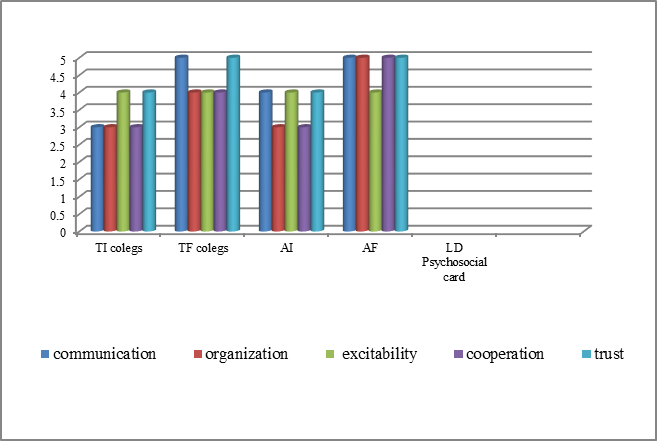
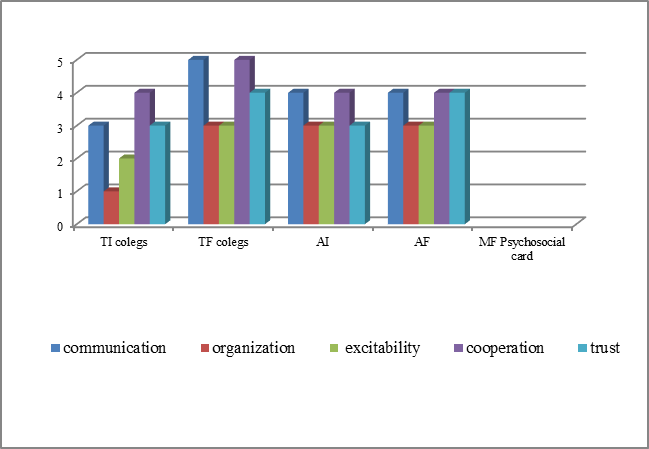
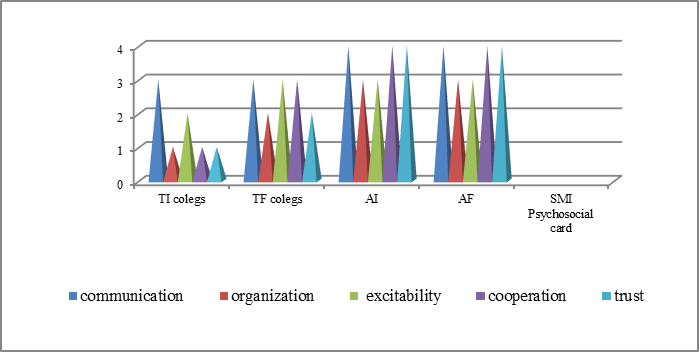
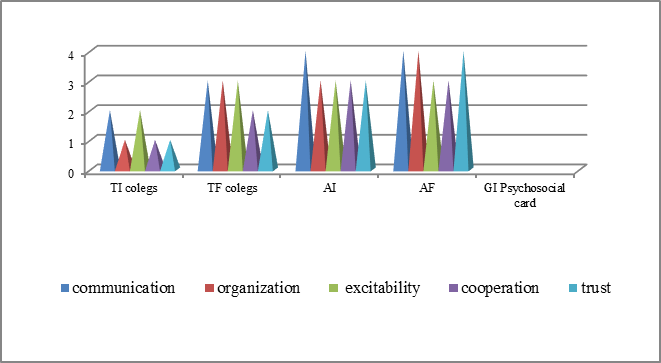
We also wanted to see if there are major differences between colleagues and personal assessments. We have taken two examples, the one of the SM student who ranks first among the positive ratings (total calculation on the 5 traits) and that of the GI student who ranks first in the list of negative assessments. As can be seen in the first case, both in terms of organizational and cooperative capacity, the marks received are high, self-evaluation being the same as that of colleagues (Figure no. 5, 6, 7, and 8).
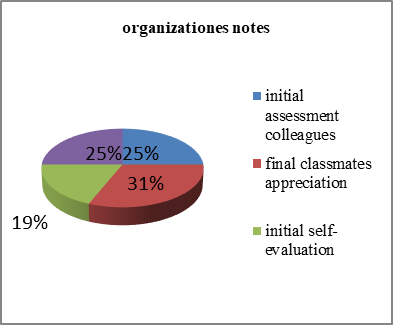
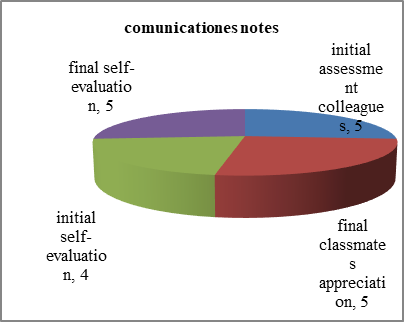
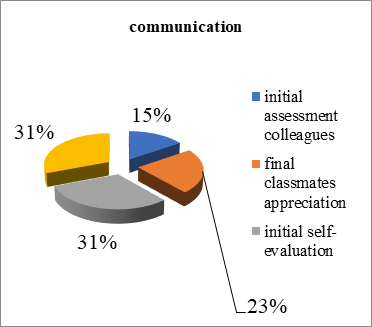
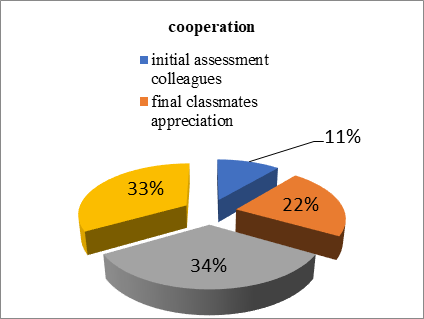
In the second case, we find a difference in the assessment of the pimited grades from colleagues and their own (Table
As can be seen in table no. 5, we have the percentage differences between the TI / TF for each surveyed question (communication, trust, project team choices, excursion colleague) for both groups, but for the experimental group these differences are much higher .
The biggest differences, as we had hoped, we obtained in the case of the experimental group, the order being a trip with colleagues, better communication, for the projects we have the third place, and the trust, which is gaining hard, is on the 4th place but with increasing percent and here. We can say that for the experimental group, interpersonal relationships have improved. For added visibility, we are redrawing the Figure
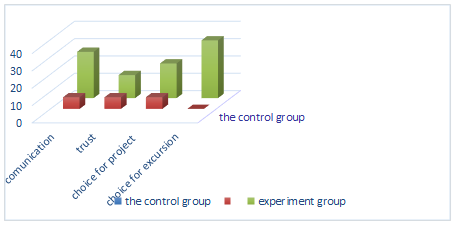
Conclusion
1. By practising physical activity under the type of dynamic games, relays, sports games, didactic games, like a competition, the student is able to develop the ability to assess other people..
2. Also, they are equally able, by reference to the others, to develop the self- assessment capacity.
3. Acquiring the objective assessment of others/ oneself is much easier when practising (mainly, but not exclusively) the above-stated physical exercises, due to the fast and correct feedback.
4. At the initial evaluation in both groups the cohesion coefficient ICG indicated poor cohesion. At the final evaluation the situation improved foor both groups, a fact that can be explained by involvement in group activities. The improvement was more proeminent for the experimental group, where specific motric activities were introduced. In correlation with this result we can notice in group A a raise of scores in all the personality dimensions that were analyzed: trust, comunication, collaboration, emotional expression.
5. All this offer support for our initial hypothesis. Another argument are the final evaluations performed by subjects in the experimental group who give close or similar grades to those received from colleagues.
6. To support the hypothesis are the results of the control group who did not perform the same exercises (their options being fitness / dance / gymnastics), failed to make comparative assessments equally correct (see graphs B students).
7. The higher percentage differences in the experimental group mean that, due to the specific body activities carried out at lessons, games based on communication, orientation - trust, etc. relationships between students in this group tend to improve.
8 Students’ replies to the questions in the survey aiming at interpersonal relationships, sympathetic-like relationships, preferences, underline the fact that their perception on colleagues changed in the experimental sample with regard to communication, confidence and collaboration.
References
- Cojanu F., & Visan P., (2016), New Perspectives of Physical Education With Integrated and Inclusive Education. The European Proceedings of Social & Behavioural Sciences EpSBS, ISSN: 2357-1330 DOI:
- Ingledew, D., Markland, D. & Medley, A. (1998). Exercise Motives And Stages Of Change. Journal Of Health Psychology, 3(4), 477-489.
- Dragnea, C.A. (2006). Psychosociology Elements of Sports Groups. Bucuresti: CD Press.
- Epuran, M. (2005). Methodology of body activity research. Bucuresti: FEST.
- Horghidan, V. (1997). Psychodiagnostic Methods. București: Didactică și Pedagogică RA.
- Neculau, A., Chelcea S., Mitrofan, N., Iluț, P., Boncu, Ș., Boza M., (…), Nastas D. (2004). Manual of Social Psychology. Iasi: a Polirom.
- Popescu, D.C. (2016). Tests and tests for handball players evaluation. Pitesti: Universității din Pitești.
Copyright information

This work is licensed under a Creative Commons Attribution-NonCommercial-NoDerivatives 4.0 International License.
About this article
Publication Date
15 August 2019
Article Doi
eBook ISBN
978-1-80296-066-2
Publisher
Future Academy
Volume
67
Print ISBN (optional)
-
Edition Number
1st Edition
Pages
1-2235
Subjects
Educational strategies,teacher education, educational policy, organization of education, management of education, teacher training
Cite this article as:
Stancu*, M. (2019). Improving Interpersonal Relations In Students Using Specific Motric Activities. In E. Soare, & C. Langa (Eds.), Education Facing Contemporary World Issues, vol 67. European Proceedings of Social and Behavioural Sciences (pp. 2117-2127). Future Academy. https://doi.org/10.15405/epsbs.2019.08.03.263
